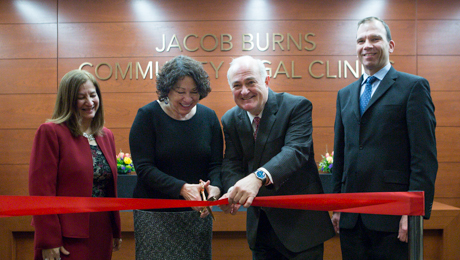Justice Sonia Sotomayor joined the George Washington University Law School community on Thursday for a ribbon-cutting ceremony dedicated to the new Jacob Burns Community Legal Clinics.
The Jacob Burns Community Legal Clinics give GW Law School students a chance to learn about lawyering through firsthand experience by enabling them to represent community members in need of legal services. The clinics now have a newly renovated building at 650 20th Street, featuring 4,000 square feet of common space, a moot courtroom, four private rooms for client interviews and five classrooms with state-of-the-art technical equipment. It also boasts a Leadership in Energy and Environmental Design (LEED) Gold rating.
Justice Sotomayor, GW President Steven Knapp, Interim Law School Dean Gregory Maggs and Phyllis Goldfarb, Jacob Burns Foundation Professor of Clinical Law and Associate Dean for Clinical Affairs, led the ribbon-cutting festivities.
Dr. Knapp introduced Justice Sotomayor, who underscored the importance of public service in the legal field and explained that she is passionate about law because the profession places a premium on pro bono work.
“To me, the students in this room, the faculty members and the administration who have supported the building of this center put on display the importance of law in service. It’s a great, great testament to the heart of GW,” Justice Sotomayor said. “Now you have a home befitting of your efforts.”
Dean Maggs said that he was delighted to present the updated clinic facilities to students, faculty and, most importantly, clients.
The George Washington University has a special connection to clinical education: Associate Dean Goldfarb explained that GW alumnus William Pincus, who earned a J.D. in the ’50s, is widely considered the father of clinical education. Calling Mr. Pincus a “visionary,” Associate Dean Goldfarb said he conceived the methods of clinical education and funded pilot programs through the Ford Foundation.
Inspired by the clinical programs that Mr. Pincus helped to create, Professor Eric Sirulnik led the effort to open a law clinic at GW more than four decades ago. The clinics received significant support from alumnus Jacob Burns, LL. B. ’24, whose generosity helped GW’s clinical program to thrive.
Today, the clinics allow students to practice international human rights, immigration law, domestic violence advocacy, community economic development law and more. Associate Dean Goldfarb pointed out the example of Sonia Desai: A student director at the clinics, Ms. Desai assisted several young girls in Jamaica who were abused while in state custody. Ms. Desai’s work may help the girls receive compensation for their traumas.
“One of the goals of clinics is to teach students the skills, habits and values of how to keep learning and growing as lawyers. That clinical method allows students to take their clinical education into practice. I can’t think of a more vibrant symbol of the clinical mission of lifelong learning as a central part of professional life than Justice Sotomayor,” she said.
The day provided the Law School community a chance to reflect on the values of the profession and rededicate themselves to service.
“The purpose every lawyer serves in whatever capacity is to help people with their problems and to try to better that client’s life situation. So long as we as lawyers act responsibly and with integrity, we serve the society in need,” Justice Sotomayor said.


